Can You Grow Sunflowers Inside? Tips, Tricks & How-to Guide
-
- Last updated:
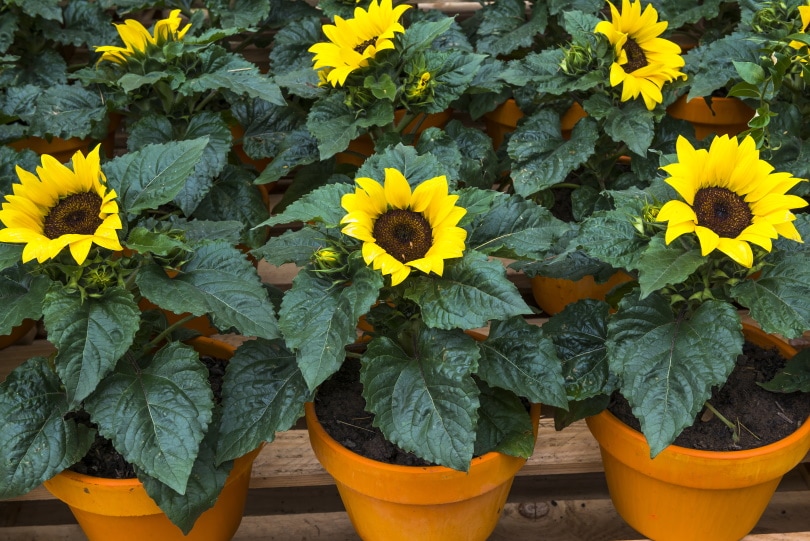
Sunflowers are known for making a statement. The stunning yellow flowers yield massive blooms atop skyscraping stems, presenting a dazzling display for the whole world to see. If you’re lucky enough to have an outdoor garden, you may feel like part of the select group that can enjoy these gorgeous annuals all to yourself.
Stately varieties may be the most familiar, but you don’t need outdoor space to start growing your own sunflowers. There are countless kinds of sunflowers, and they come in a broad array of sizes, including miniature varieties perfect for pots. To get you started on a successful indoor growing season, we’ll walk you through tips and tricks on how you can grow sunflowers inside.

Choosing a Sunflower Variety
Many sunflower varieties known for their enormous stature would be a challenge to grow indoors. American Giant, Sunforest Mix, and Russian Mammoth offer stunning gorgeous blooms, but growing up to 15 feet tall, their container and space requirements are often too much for most households.
Fortunately, over 50 sunflower varieties are native to North America, and not all of them grow to towering heights. Elf varieties are some of the tiniest sunflowers, only standing about 16 inches tall at most. Other short-growing and house-friendly sunflower species to try include:

- Little Becka
- Sunny Smile
- Firecracker
- Suntastic Yellow
- Mars
- Pacino
- Teddy Bear
- Elegance
- Strawberry Blonde
Choose your sunflower variety carefully, as they cover a vast size range. It’s crucial to have the appropriate window and container space to let your sunflowers grow to their mature size without issue. Most sunflowers have the same general soil, water, and sunlight needs, but you must follow the package directions for any unique considerations with your particular variety.
Finding a Sunny Location
It’s no surprise that sunflowers like the sun. These heliotropic flowers follow the sun in the sky, requiring at least 6–8 hours of direct exposure every day. Position your sunflowers in a west or south-facing window to ensure they receive as much light as possible.
Sunflowers prefer warm temperatures around 70°–80°F during the day and slightly cooler temperatures of roughly 55°–60°F at night. Control the climate as well as you can, and ensure the plants aren’t close to any heating or cooling source, like an appliance, furnace, air conditioning vent, or drafty window.
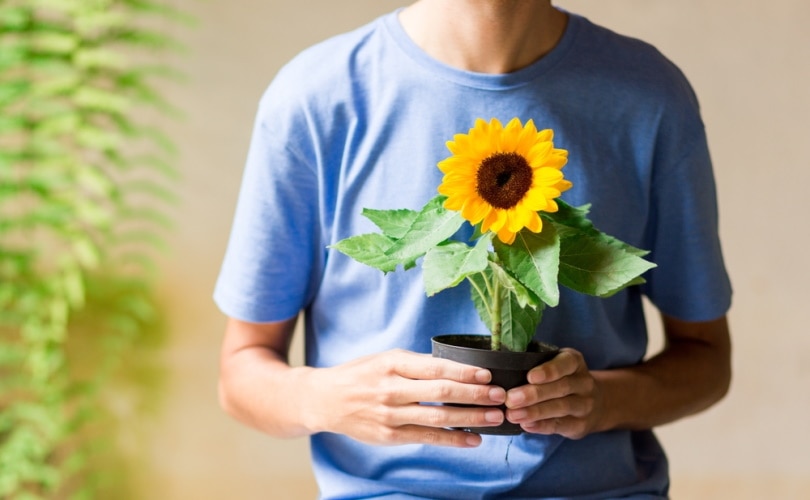
Artificial Lights
You can supplement natural sunlight with LED or fluorescent lights if you can’t give them at least 6 hours in the window. Keep the light at least 6 inches above the top of the plant as it grows. Use a grow light for 8–12 hours in place of sunlight, and turn it off in the evening to give your sunflowers some rest.
Choosing a Container
You can germinate sunflower seeds in starter trays, but as they grow, you’ll eventually need to transfer them to larger pots. Dwarf sunflower varieties can grow in 1-gallon pots roughly 6” wide and 6” deep. Sunflowers that grow 2–4’ tall will need at least a 10–12” diameter pot, and anything over 4’ will likely need at least a 5-gallon pot.
If you plan to grow several sunflowers in a single pot, make sure they have at least 6–8” of space between them. Taller sunflower varieties will need more space around them. No matter what pot you use, make sure it has drainage holes to let excess water out.
Sunflower Soil Requirements
Sunflowers thrive in nutrient-rich, well-drained soil that stays moist and has a pH between 6 and 7.5. A general-purpose potting soil works well in most cases. You can also add a layer of mulch on top to help with moisture retention, but be careful to keep it away from the sunflower stems.
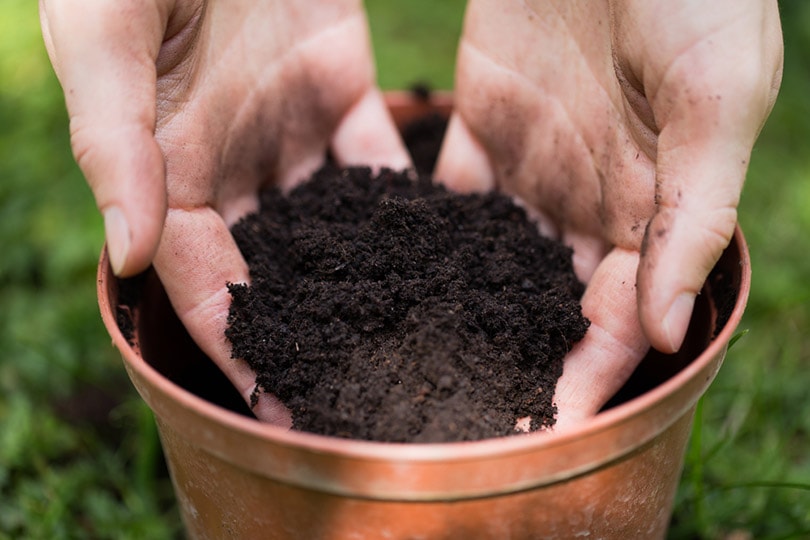
How to Grow Sunflowers Inside
To grow sunflowers inside, plant seeds in a starter tray or one per pot, poking them about 1 inch into the soil. You can encourage faster germination by soaking the seeds for about 6 hours before planting.
While you’re waiting for the seeds to sprout, the soil needs to be kept warm and moist. Water the seeds lightly every day, making sure to keep the soil saturated but not soggy. Place the pots in a warm sunny area to keep the soil at the optimal temperature of roughly 60°F.
Maintaining Sunflowers
After your sunflowers begin to sprout, you can transplant them into their final container and arrange them as desired. Giving sunflowers space will allow them to grow to their full potential, while planting them closer together will inspire more stunted growth, which may be preferable depending on the circumstances.
Sunflowers will sprout about 7–10 days after sowing. After they emerge, you can cut the watering schedule back to about one inch of water one day a week. Check the top inch of soil, and add water if it feels dry.
You usually won’t need to fertilize sunflowers, but a touch of organic fertilizer will give them a boost nevertheless. Feel free to apply a small amount with every watering or a couple of times during the growing season, but avoid overdoing it. You can also add a slow-release fertilizer or organic compost to the prepared soil before planting, and you will likely not have to add any more in the future.
Depending on the variety, sunflowers mature in 80–120 days. As they grow, you may need to secure them with stakes or trellises to keep them from falling over, especially when they get over 36” tall. Blooms will emerge after roughly ten weeks and hang around for another 3–4 weeks before wilting.
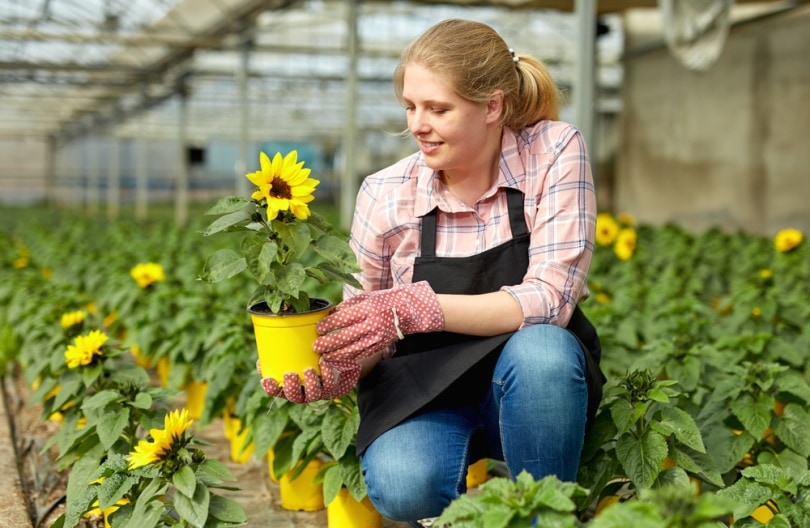
What Can You Do With Sunflowers?
Sunflowers are gorgeous cut flowers, and their seeds make a healthy snack, both for you and all the wildlife that outdoor varieties can attract to your yard.
When selecting flowers for a vase, pick sunflowers that haven’t fully opened and are just starting to lift their petals from their centers. Cut them early in the morning after the dew dries to keep them fresh for as long as possible. To keep the stems from sitting flat on the bottom of the vase, cut them at a 45° angle at the desired length.
Add your sunflowers to a vase with fresh water, making sure not to overcrowd the heads. Change the water every other day, and position them out of direct sunlight. For a longer-lasting bouquet, you can make DIY plant food by mixing 1 tablespoon of sugar and ¾ teaspoon of bleach in a gallon of water.
Harvesting Sunflower Seeds
Seeds develop as the head of the flower starts to wilt. When you notice it starting to droop, cut the flower off below the base of the head and hang it up to let it dry. The leaves will wither and fall off, and the seeds will loosen. You can then remove the seeds by rubbing two sunflower heads together or scraping the seeds off with a fork.
Since sunflowers are an annual plant, you can hold onto the seeds for the next time you want to grow them. Rinse the seeds and set them aside to dry for several hours before storing them. Keep them in an airtight container in a cool, dry place, which can allow them to last several years.
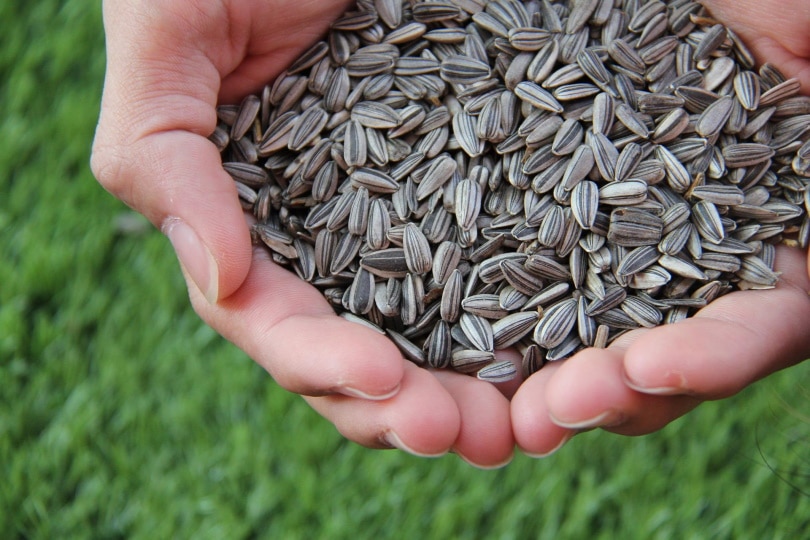

Final Thoughts
We may know and love sunflowers for their untamed grandeur and radiance in outdoor fields and along roadsides, but with some careful forethought, you can easily harness that same charm in the comfort of your home.
With all of the unique varieties available, you can find sunflowers in several shapes, sizes, and colors. There’s tons of room to make sunflowers a fitting part of your decor. Follow these tips and tricks to grow sunflowers inside, and you’ll treat yourself to spectacular blooms throughout the entire year.
Featured Image Credit: BBA, Shutterstock
Contents

